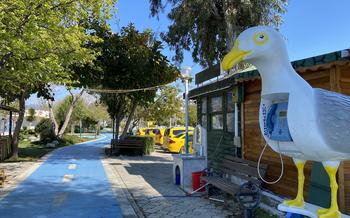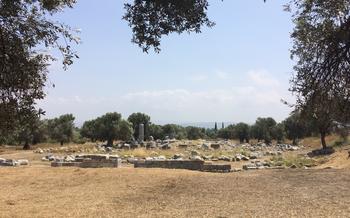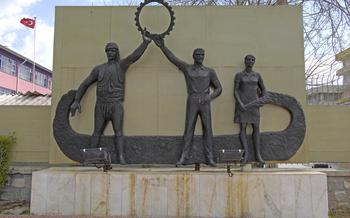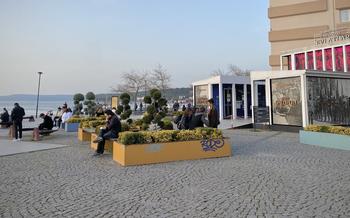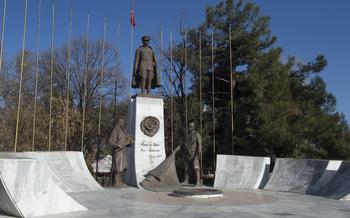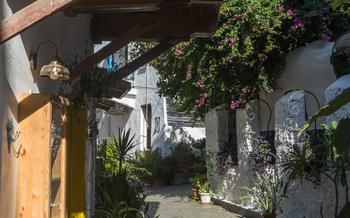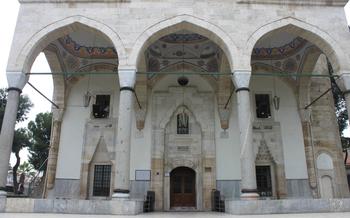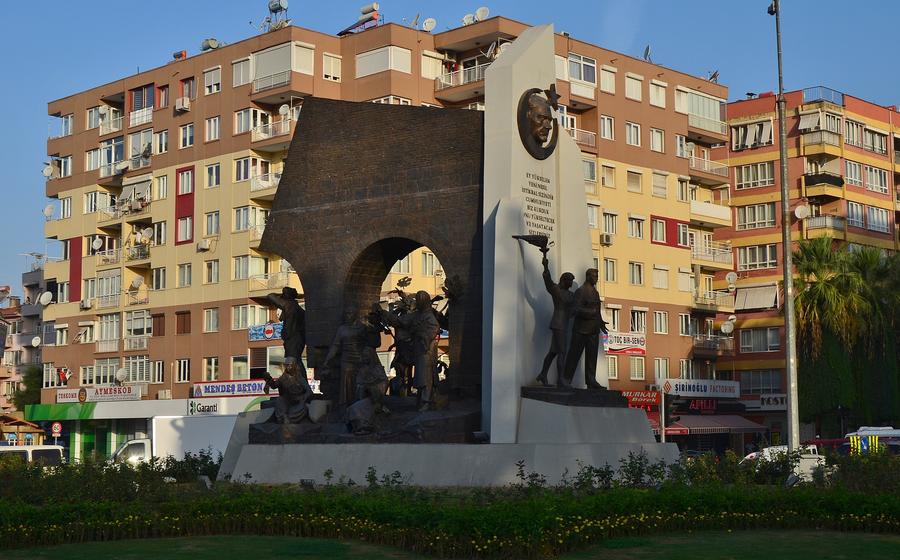
Nyssa Ancient City
- Nyssa Ancient City: Unveiling the Marvels of Aydın's Past
- A Journey Through Time: Exploring the Ancient Streets
- The Odeon and Theater: Stages of Ancient Performances
- The Temple of Apollo: A Sanctuary of Worship
- The Gymnasium: A Place for Physical Training and Recreation
- The Necropolis: Eternal Resting Place of Nyssa's Citizens
- The Museum of Nyssa: A Treasure Trove of Ancient Artifacts
- The Agora: Center of Commerce and Social Life
- The Baths: Relaxation and Hygiene in Ancient Times
- The Aqueduct: Engineering Marvel of Ancient Nyssa
- The City Walls: Fortification and Protection
- The Byzantine Church: A Legacy of Christian Heritage
- The Olive Groves of Aydın: A Culinary Delight
- Local Cuisine and Delicacies: A Culinary Adventure
- Insider Tip: Hidden Gems and Local Secrets
Nyssa Ancient City: Unveiling the Marvels of Aydın's Past
Journey back in time as you explore the captivating ruins of Nyssa, an ancient city nestled in the heart of Aydın, Turkey. Immerse yourself in its rich history, dating back to the Hellenistic period, and discover the remarkably preserved ruins that tell the story of a once-thriving metropolis. Marvel at the architectural wonders, including temples, theaters, and more, and let the natural beauty of the surroundings captivate you as you take in panoramic views that stretch as far as the eye can see. Engage with local experts and learn about the ongoing excavations that continue to unveil the secrets of this ancient city, offering a unique glimpse into the lives of those who once called Nyssa home.
A Journey Through Time: Exploring the Ancient Streets
Step back in time as you wander through the ancient streets of Nyssa, a city that once bustled with life. Imagine the hustle and bustle of daily activities as you explore the well-preserved ruins that tell the story of this remarkable city.
Admire the impressive buildings that line the streets, including the bouleuterion, where the city council once convened, and the agora, the center of commerce and social life. Discover hidden gems tucked away in the corners of the city, such as lesser-known ruins and artifacts that offer a glimpse into the daily lives of Nyssa's inhabitants.
Enhance your visit by participating in guided tours or using multimedia guides that bring the ancient city to life. Let the stories of the past resonate as you walk in the footsteps of those who lived here centuries ago, immersing yourself in the rich history and culture of Nyssa.
The Odeon and Theater: Stages of Ancient Performances
The Odeon and Theater of Nyssa stand as testaments to the city's rich cultural heritage. The Odeon, a smaller venue, was likely used for musical performances, recitals, and poetry readings. Its excellent acoustics, achieved through careful architectural design, ensured that every word and note could be heard clearly by the audience.
The Theater, on the other hand, was a grander structure intended for larger-scale performances, such as plays, dramas, and comedies. Its impressive stage, adorned with intricate carvings and sculptures, provided a backdrop for captivating performances that transported audiences to different worlds.
Beyond their architectural grandeur, these venues hold immense cultural significance. They offer a glimpse into the artistic traditions and entertainment enjoyed by the ancient Greeks and Romans. Imagine the laughter and applause that filled the air as actors brought mythical tales to life or musicians captivated listeners with their melodies.
Today, the Odeon and Theater continue to serve as stages for cultural events. Modern-day performances, concerts, and plays are held in these historic venues, allowing visitors to experience the magic of ancient Greek theater in a truly authentic setting.
The Temple of Apollo: A Sanctuary of Worship
Dedicated to the Greek god Apollo, the Temple of Apollo stands as a testament to the city's deep-rooted religious beliefs. The temple's grand entrance, adorned with intricate carvings and sculptures, invites visitors to step back in time and experience the sacred atmosphere of this ancient sanctuary. Inside, the temple's impressive columns, pediments, and friezes showcase the architectural prowess of the ancient Greeks.
As you explore the temple, you will discover the various rituals and ceremonies that took place within its walls. Learn about the offerings made to Apollo, the prayers recited by worshippers, and the significance of the temple in the religious life of Nyssa. Ongoing excavations at the site continue to uncover new artifacts and insights into the temple's history and practices, offering a glimpse into the spiritual beliefs of the ancient Greeks.
The Gymnasium: A Place for Physical Training and Recreation
In ancient Greek culture, physical fitness was highly valued, and the gymnasium played a crucial role in promoting this ideal. Nyssa's gymnasium, located near the city center, offers a fascinating glimpse into the ancient Greek approach to physical training and recreation.
With its impressive size and well-preserved remains, the gymnasium showcases various training facilities and amenities. Visitors can explore the palaestra, a large open courtyard surrounded by colonnades, where athletes engaged in wrestling, boxing, and other sports. The gymnasium also features a spacious exercise hall with stone benches and weights, where athletes could build strength and endurance.
Beyond its physical training function, the gymnasium served as a significant social gathering place for men. Here, they could socialize, discuss philosophy, and engage in intellectual pursuits. The gymnasium was a hub of cultural and intellectual exchange, fostering a sense of community among its members.
The gymnasium's enduring legacy is a testament to the importance ancient Greeks placed on physical fitness and overall well-being. Its ruins invite visitors to step back in time and experience the vibrant atmosphere of this ancient institution, where mind and body were nurtured in harmony.
The Necropolis: Eternal Resting Place of Nyssa's Citizens
The Necropolis of Nyssa, an ancient city in Aydın, Turkey, offers a glimpse into the diverse burial customs and practices of the ancient Greeks. Explore various types of tombs, including rock-cut and chamber tombs, each with unique architectural features and inscriptions. Decipher epitaphs and inscriptions to gain insights into the lives and legacies of Nyssa's citizens. Discover the artifacts and grave goods found in the tombs, shedding light on ancient funerary practices and beliefs. The Necropolis provides a fascinating glimpse into the lives and deaths of the people who once inhabited this ancient city.
The Museum of Nyssa: A Treasure Trove of Ancient Artifacts
The Museum of Nyssa stands as a testament to the city's rich history and cultural heritage. Within its walls, visitors can embark on a journey through time, exploring a diverse collection of artifacts that offer glimpses into the lives and customs of Nyssa's ancient inhabitants.
Among the museum's highlights are exquisite sculptures that depict mythological figures, gods, and goddesses. These works of art, carved with intricate detail and precision, provide a glimpse into the artistic prowess of ancient Greek artisans.
The museum also houses a remarkable collection of pottery, ranging from humble household items to finely crafted vases adorned with intricate designs. These artifacts shed light on the everyday lives of Nyssa's citizens, their culinary practices, and their trade relations with neighboring regions.
Jewelry lovers will be captivated by the museum's collection of precious ornaments, including necklaces, earrings, and rings. These pieces, crafted from gold, silver, and gemstones, showcase the skill and artistry of ancient goldsmiths and the opulence of Nyssa's elite.
Interactive displays and multimedia presentations enhance the museum experience, allowing visitors to delve deeper into the history and significance of the artifacts. Guided tours led by knowledgeable experts provide a personalized and informative journey through the museum's collection, offering insights into the lives and culture of Nyssa's ancient inhabitants.
The Agora: Center of Commerce and Social Life
In the heart of ancient Nyssa, the agora served as a bustling marketplace and a vibrant center of social and political activities. Imagine the lively atmosphere as merchants displayed their wares, traders negotiated prices, and shoppers haggled for the best deals. The agora was not merely a place of commerce; it was also a place where citizens gathered to discuss politics, attend assemblies, and celebrate festivals.
Explore the well-preserved remains of the agora and admire the surrounding civic buildings, including the bouleuterion (council chamber) and the prytaneion (administrative building). Decipher inscriptions on stone tablets that provide insights into the laws, regulations, and decisions that shaped the ancient city's governance.
Uncover artifacts such as pottery shards, coins, and tools that offer glimpses into the daily lives of Nyssa's inhabitants. Imagine the hustle and bustle of the marketplace, the laughter and chatter of friends meeting, and the speeches of politicians swaying the crowd. The agora was a place of vibrant energy, where the pulse of the city beat strong.
The Baths: Relaxation and Hygiene in Ancient Times
In ancient Nyssa, the baths played a crucial role in the daily lives of its citizens. These elaborate structures were not merely places for cleansing but also served as centers for relaxation, socialization, and hygiene. The well-preserved remains of the baths offer a glimpse into the bathing rituals and customs of the ancient Greeks and Romans.
The baths typically consisted of several rooms, each serving a specific purpose. The frigidarium, or cold room, was used for cooling down after a hot bath. The tepidarium, or warm room, provided a transition between the cold and hot rooms. The caldarium, or hot room, was the hottest and most humid room, where bathers would sweat and cleanse their bodies.
Bathing rituals in ancient Nyssa were elaborate and time-consuming. Bathers would typically start by anointing themselves with oil to protect their skin from the heat and moisture. They would then scrape their bodies with a strigil, a curved metal instrument, to remove dirt and sweat. After sweating in the caldarium, bathers would plunge into a cold pool to cool down.
The baths were also an important place for socialization. People from all walks of life would gather in the baths to relax, chat, and catch up on the latest news. The baths were also a place for men to conduct business and discuss politics.
The archaeological evidence found in the baths provides valuable insights into the lives of the ancient Nyssans. Excavations have uncovered a variety of artifacts, including strigils, oil lamps, and coins. These artifacts help us to understand the bathing practices and customs of the time.
Visiting the baths of ancient Nyssa is a unique opportunity to learn about the daily lives of the city's inhabitants. These well-preserved ruins offer a glimpse into the past and provide a fascinating insight into the bathing culture of the ancient world.
The Aqueduct: Engineering Marvel of Ancient Nyssa
In the arid landscape of ancient Nyssa, water was a precious commodity. To ensure a reliable supply, the city's inhabitants constructed an impressive aqueduct, an engineering marvel that stands as a testament to their ingenuity and perseverance.
The aqueduct, stretching for several kilometers, brought water from distant springs and rivers into the city. Its intricate system of channels and arches, meticulously crafted from stone and mortar, defied gravity and ensured a steady flow of water throughout the year.
The aqueduct's construction required immense skill and precision. Workers carefully surveyed the terrain, determining the optimal route for the water to flow. They built sturdy piers and arches to support the channels, ensuring their stability even in the face of earthquakes and other natural disasters.
The aqueduct not only provided a vital water supply but also played a significant role in the city's sanitation. It helped to drain wastewater away from the city, reducing the risk of disease and improving public health.
Today, the ruins of the aqueduct stand as a reminder of Nyssa's remarkable engineering prowess. Visitors can explore the remains of the channels, arches, and reservoirs, marveling at the ingenuity of the ancient builders who created this lifeline for their city.
The City Walls: Fortification and Protection
The city walls of Nyssa stand as a testament to the city's rich history and its strategic importance throughout the ages. These impressive fortifications were constructed to protect Nyssa from invaders and secure its borders, ensuring the safety and prosperity of its citizens.
The walls were built using a variety of materials, including stone, brick, and mortar, and feature a number of defensive structures, such as towers, gates, and ramparts. The towers were used for surveillance and defense, providing a vantage point for soldiers to spot approaching enemies and launch counterattacks. The gates were the main entrances to the city, and were heavily fortified to prevent unauthorized entry. The ramparts were thick, high walls that formed the main defensive barrier of the city, protecting it from attack.
The city walls of Nyssa are a remarkable feat of engineering and a symbol of the city's resilience and strength. They have withstood the test of time, and continue to stand as a reminder of Nyssa's rich and storied past.
The Byzantine Church: A Legacy of Christian Heritage
Amidst the ancient ruins of Nyssa, stands a testament to the region's rich Christian heritage - the Byzantine church. This architectural marvel, dating back to the 6th century AD, is a captivating fusion of Byzantine and early Christian styles. Its well-preserved structure, featuring intricate domes, graceful arches, and exquisite mosaics, transports visitors back in time.
Step inside the church to marvel at the vibrant frescoes and mosaics that adorn its walls and ceilings. These intricate artworks depict biblical scenes, saints, and religious symbols, offering a glimpse into the spiritual beliefs and artistic traditions of the Byzantine era.
Explore the ongoing archaeological excavations surrounding the church, which are uncovering new insights into its history and significance. Discover hidden chambers, unearthed artifacts, and learn about the daily lives of the early Christian community that once worshipped within these sacred walls.
Whether you're a history buff, an architecture enthusiast, or simply seeking spiritual inspiration, the Byzantine church of Nyssa is a must-visit destination. Its enduring presence amidst the ruins of the ancient city serves as a reminder of the enduring power of faith and the cultural legacy of the Byzantine Empire.
The Olive Groves of Aydın: A Culinary Delight
In the heart of the Aydın region, olive groves stretch as far as the eye can see, painting a picturesque landscape that reflects the region's rich agricultural heritage. The cultivation of olives in Aydın dates back centuries, with the region renowned for producing some of the finest olives and olive oil in Turkey. Visitors can immerse themselves in this culinary tradition by exploring the olive groves, learning about the different varieties of olives grown in the region, and witnessing the process of olive oil production firsthand. From harvesting the olives to pressing them into oil, the experience offers a glimpse into the dedication and skill that goes into creating this liquid gold. Indulge in local dishes that showcase the flavors of Aydın's olives, such as olive oil-based mezzes and traditional Turkish cuisine. Aydın's cuisine is a testament to the region's deep connection to its agricultural roots, and a culinary adventure here is sure to delight the taste buds of any food enthusiast.
Local Cuisine and Delicacies: A Culinary Adventure
Indulge in the culinary delights of Aydın, where traditional Turkish, Greek, and Mediterranean flavors blend harmoniously. The region's fertile lands and rich history have given rise to a diverse cuisine that showcases the freshest ingredients and unique culinary techniques. Explore vibrant local markets brimming with fresh produce, herbs, and spices, where you can gather the ingredients to create your own culinary masterpiece. Sample the delectable olive oil-based dishes that are a staple of Aydın's cuisine, such as zeytinyağlı yemekler (olive oil dishes) and mezeler (appetizers). These dishes are a testament to the region's centuries-old tradition of olive cultivation and the exceptional quality of its olive oil. Participate in cooking classes or food tours to learn more about Aydın's cuisine and try your hand at preparing local dishes, immersing yourself in the flavors and traditions of this culinary paradise.
Insider Tip: Hidden Gems and Local Secrets
Beyond the well-known attractions, Aydın and its surroundings offer a treasure trove of hidden gems and local secrets waiting to be discovered. Venture off the beaten path to uncover ancient ruins that have yet to be fully explored, immerse yourself in local festivals and events that showcase the region's vibrant culture, and seek out secluded natural wonders that provide a tranquil escape from the tourist crowds. Ask locals for their recommendations on where to find the most authentic restaurants, shops, and experiences that may not be listed in guidebooks. Embrace the opportunity to connect with the local community and gain a deeper understanding of Aydın's rich heritage and traditions.
